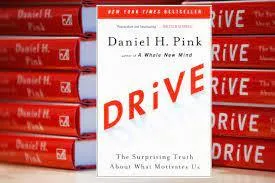
Blog

Unlocking Employee Motivation: Insights from Daniel Pink's Research
Employee motivation is a crucial aspect of any successful organization. Understanding what drives individuals to perform at their best can significantly impact productivity, job satisfaction, and overall company success. In his groundbreaking book "Drive: The Surprising Truth About What Motivates Us," Daniel Pink delves into the science of motivation, revealing key insights that can revolutionize the way we approach employee engagement and satisfaction.
1. The Three Pillars of Motivation
Daniel Pink identifies three essential elements that drive motivation in the workplace:
a. Autonomy
Autonomy refers to the desire to direct our own lives and work. Employees are most motivated when they have the freedom to make choices and have control over their tasks. This sense of autonomy fosters a sense of ownership and responsibility, leading to increased job satisfaction and productivity.
b. Mastery
Mastery is the desire to continually improve and grow in our skills and knowledge. Pink's research highlights that individuals are most motivated when they can develop their abilities and strive for personal growth. Providing opportunities for skill development and learning can significantly enhance motivation and job engagement.
c. Purpose
Purpose entails a deeper connection to something more significant than ourselves. Employees seek meaning and purpose in their work. When they understand how their contributions align with the organization's mission and goals, they feel a sense of purpose and are more motivated to excel.
2. Reimagining the Work Environment
Understanding these motivational pillars allows organizations to rethink their work environments and management practices. By incorporating autonomy, mastery, and purpose into the fabric of the workplace, companies can create a more motivated and engaged workforce.
a. Fostering Autonomy
Organizations can empower employees by granting them the autonomy to make decisions related to their work. This can involve giving them control over project timelines, work processes, and even choosing the projects they work on. Trusting employees to make significant decisions cultivates a sense of responsibility and motivation to perform at their best.
b. Encouraging Mastery
Providing ample opportunities for skill development and growth is vital. Managers should support employees in honing their skills and mastering their roles through continuous learning, training programs, mentorship, and constructive feedback. Recognizing and celebrating their progress and achievements can further boost motivation.
c. Clarifying Purpose
Communicating a clear and inspiring organizational vision is crucial in helping employees understand the purpose of their work. Employees should see how their contributions align with the company's mission and how their efforts impact the larger goals. Regular communication and transparency about the company's purpose can create a sense of meaning in their work.
3. Leadership's Role in Motivation
Effective leadership is central to implementing these motivational principles in the workplace. Leaders must understand their employees' needs and preferences, tailor opportunities for autonomy, mastery, and purpose, and foster a culture that prioritizes these elements.
Conclusion
Daniel Pink's research sheds light on the fundamental aspects that drive employee motivation—autonomy, mastery, and purpose. Incorporating these principles into organizational culture and leadership practices can lead to a more motivated and engaged workforce. As we navigate the dynamics of the modern workplace, understanding and leveraging these motivational factors are key to fostering a thriving and successful work environment.
Note: The insights and principles mentioned in this blog post are based on Daniel Pink's book "Drive: The Surprising Truth About What Motivates Us."
To learn more about the services we offer, please click here. To get in touch with me, please click here or give me a call at (617) 281-3215.

Unlocking Employee Motivation: Insights from Daniel Pink's Research
Employee motivation is a crucial aspect of any successful organization. Understanding what drives individuals to perform at their best can significantly impact productivity, job satisfaction, and overall company success. In his groundbreaking book "Drive: The Surprising Truth About What Motivates Us," Daniel Pink delves into the science of motivation, revealing key insights that can revolutionize the way we approach employee engagement and satisfaction.
1. The Three Pillars of Motivation
Daniel Pink identifies three essential elements that drive motivation in the workplace:
a. Autonomy
Autonomy refers to the desire to direct our own lives and work. Employees are most motivated when they have the freedom to make choices and have control over their tasks. This sense of autonomy fosters a sense of ownership and responsibility, leading to increased job satisfaction and productivity.
b. Mastery
Mastery is the desire to continually improve and grow in our skills and knowledge. Pink's research highlights that individuals are most motivated when they can develop their abilities and strive for personal growth. Providing opportunities for skill development and learning can significantly enhance motivation and job engagement.
c. Purpose
Purpose entails a deeper connection to something more significant than ourselves. Employees seek meaning and purpose in their work. When they understand how their contributions align with the organization's mission and goals, they feel a sense of purpose and are more motivated to excel.
2. Reimagining the Work Environment
Understanding these motivational pillars allows organizations to rethink their work environments and management practices. By incorporating autonomy, mastery, and purpose into the fabric of the workplace, companies can create a more motivated and engaged workforce.
a. Fostering Autonomy
Organizations can empower employees by granting them the autonomy to make decisions related to their work. This can involve giving them control over project timelines, work processes, and even choosing the projects they work on. Trusting employees to make significant decisions cultivates a sense of responsibility and motivation to perform at their best.
b. Encouraging Mastery
Providing ample opportunities for skill development and growth is vital. Managers should support employees in honing their skills and mastering their roles through continuous learning, training programs, mentorship, and constructive feedback. Recognizing and celebrating their progress and achievements can further boost motivation.
c. Clarifying Purpose
Communicating a clear and inspiring organizational vision is crucial in helping employees understand the purpose of their work. Employees should see how their contributions align with the company's mission and how their efforts impact the larger goals. Regular communication and transparency about the company's purpose can create a sense of meaning in their work.
3. Leadership's Role in Motivation
Effective leadership is central to implementing these motivational principles in the workplace. Leaders must understand their employees' needs and preferences, tailor opportunities for autonomy, mastery, and purpose, and foster a culture that prioritizes these elements.
Conclusion
Daniel Pink's research sheds light on the fundamental aspects that drive employee motivation—autonomy, mastery, and purpose. Incorporating these principles into organizational culture and leadership practices can lead to a more motivated and engaged workforce. As we navigate the dynamics of the modern workplace, understanding and leveraging these motivational factors are key to fostering a thriving and successful work environment.
Note: The insights and principles mentioned in this blog post are based on Daniel Pink's book "Drive: The Surprising Truth About What Motivates Us."
To learn more about the services we offer, please click here. To get in touch with me, please click here or give me a call at (617) 281-3215.
